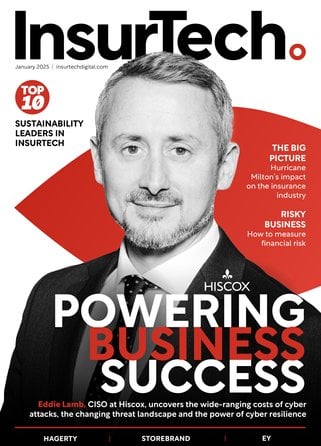Markel: Firms Face £25M Deepfake Fraud Threat

InsurTech Digital's sister publication FinTech Magazine speaks to Nick Rugg, Head of Fintech and Investment Management Insurance at Markel International on the rise of fraud and how fintechs can manage with its growing sophistication.
Walk us through the cyber fraud landscape as you see it today?
Cyber fraud is increasing in complexity and sophistication. Last year, a convincing deepfake of a finance officer on a video call tricked an employee in Hong Kong into transferring US$25.6m across 15 transactions – causing significant financial and reputational damage to the business.
Companies of all types are targets - including fintechs, which often play a key role in payment transfers, digital banking, and financial services.
In the 12 months to October 2024, 79% of UK fintech firms lost at least £500,000 to fraud. Two in five recorded losses between £1m (US$1.35m) and £5m (US$6.75m) in that time, and nearly nine per cent said they lost over £5m, according to risk services provider, Alloy.
The increasing fraud threat raises vital questions for fintechs around risk management and business resilience.
How is fraud becoming more sophisticated?
The deepfake fraud in Hong Kong is not a one-off event. Fraudsters are creating life-like images using biometric data in the form of facial images, vocals, DNA and fingerprints to impersonate people online.
Known as synthetic fraud, creating entirely fictitious identities online and acting as humans is on the rise.
According to a 2024 survey undertaken by Regula, a global developer of forensic devices and identity verification solutions, it reported that 49% of companies surveyed experienced video or audio deepfakes. This was an increase of 20% and 12% respectively compared to 2022.
However, many criminals don’t even need to go that far. Often, fake documentation alone is enough to deceive a company. This type of synthetic fraud is more common.
Using sophisticated software and artificial intelligence, they mix real and fake information to create false identities and then submit document information.
This allows them to open accounts, receive money, and then disappear. The authenticity of these types of fraud makes it hard for fintechs to detect and stop.
Ransomware continues to be a major threat. The Gov.UK Cyber Security Breaches Survey 2025 estimates that 19,000 UK businesses experienced a ransomware attack in the past 12 months, where criminals are targeting key infrastructure.
Banks and financial institutions, where fintech plays a key role, face the risk of having parts of their systems frozen as threat actors attempt to swoop in and steal confidential data and monies from these businesses.
If the payment network is compromised, monetary transactions could cease, causing serious economic harm.
The rise in artificial intelligence (AI) is playing an increasingly significant role in fraud. Although AI is used in cyber defence, criminals employ it strategically to target companies with the weakest cyber defences and then identify their soft entry points.
AI can understand cyber defence detection patterns and adapt dynamically to bypass defences. It can learn large datasets to create highly convincing and personalised phishing messages. It has helped fuel a rise in fraud which has now got the eye of the authorities.
"Under the amended regulations, payment service providers are now more accountable for ensuring that customers have verified the payment request and that the account to which the funds are being sent is legitimate"
What other growing responsibilities do fintechs face?
Alongside the growing cyber threat, fintech faces increased payment and regulatory responsibilities. The Payment Services (Amendment) Regulations 2024, which came into force in October last year, marks a major change.
It is a UK legislative update aimed at combating the growing threat of Authorised Push Payment (APP) fraud which is a type of scam where individuals are tricked into sending money to fraudsters.
Prior to these regulations, customers often bore the financial burden for APP fraud incidents. However, the new rules are designed to shift this liability away from the customer and on to the sending and receiving payment service provider.
Under the amended regulations, payment service providers are now more accountable for ensuring that customers have verified the payment request and that the account to which the funds are being sent is legitimate.
The aim of this is to enhance the fraud controls that payment service providers have in place for outgoing and incoming payments.
If they do process a payment that turns out to be APP fraud, they will have to reimburse the customer which can be costly and includes payments with a value up to £85,000 (US$114,000). This applies to all payments made via the Faster Payments Network and CHAPS.
"Fintechs are busy companies, often fast-growing and focused on customer innovation. Instead of having multiple insurance policies, fintech companies should seek an all-in-one policy that captures the growing fraud and cyber threats, as well as core financial risks"
How can fintechs build resilience with these myriad responsibilities?
Fintechs are busy companies, often fast-growing and focused on customer innovation. Instead of having multiple insurance policies, fintech companies should seek an all-in-one policy that captures the growing fraud and cyber threats, as well as core financial risks.
The insurance market is keeping pace, offering comprehensive policies, which can cover liability claims against the company and the directors and officers, as well as crime, cyber liability and first party loss. They also extend to escalating cyber threats such as cryptojacking and telecom fraud.
Fintechs can now access value-added services via their insurance to better manage their risk. For instance, they can benefit from 24-hour legal helplines available at any time.
The advice can be crucial in preventing losses and avoiding insurance claims. This is especially valuable for smaller or start-up fintechs that may not have access to in-house lawyers. Additionally, they can take advantage of supplementary services such as tax advice support.
Fintechs can obtain a free initial consultation, helping them decide whether to pay for full advisory services. These services provide vital support, allowing fintechs to navigate challenges more effectively and with greater confidence.
In conclusion, fintech businesses face increasing crime and cyber threats and stricter regulations, making resilience more important than ever. Having comprehensive insurance and access to expert advice can help them manage risks effectively.
By keeping on top of these increasing threats, strengthening their risk management processes and having a tailored insurance policy for their risk exposures, fintechs can protect their business, build trust with customers, and continue to grow confidently into the future.
Explore the latest edition of FinTech Magazine and be part of the conversation at our global conference series, FinTech LIVE.
Discover all our upcoming events and secure your tickets today.
FinTech Magazine is a BizClik brand
Featured Articles
German insurer Allianz cites changing customer preferences and technology advances as workforce reduction affects multiple business lines
Charles Taylor InsureTech launches 'Bordereaux Sync', an AI-powered tool that screens and repairs data errors before they enter management systems
New insurance facility offers up to €1bn coverage for large-scale data centre projects across UK and Europe as demand for digital infrastructure soars




